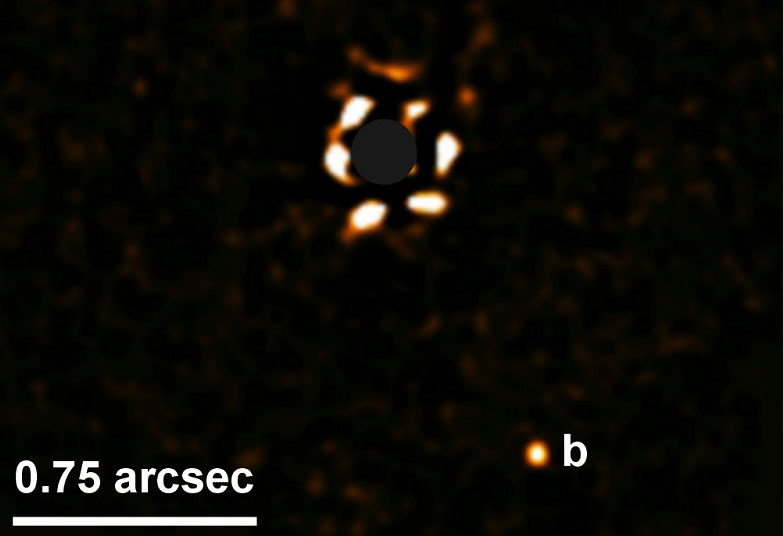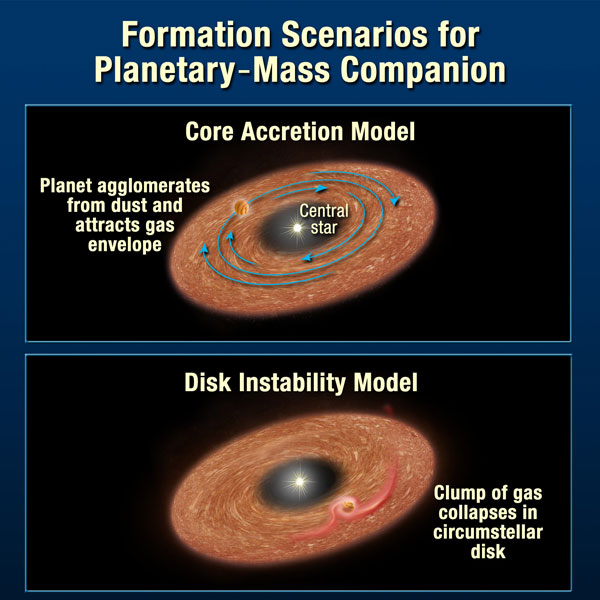Astronomers have discovered a super-Jupiter orbiting its young star on a surprisingly wide orbit. How did it get there?

ESO/SPHERE/VLT/Bohn et al.
Scientists have just obtained images of giant planet around a young star about 360 light-years away in the southern constellation Musca, the Fly. The planet is a gas giant, not an unusual find in itself. However, it’s located about 110 times farther from its star than Earth is from the Sun, and astronomers are puzzled how such a large planet could have formed so far from its star. Their findings will appear in Astronomy & Astrophysics (preprint available here).
The planet, YSES 2b, was found as part of the Young Suns Exoplanet Survey (YSES), which began monitoring 70 stars resembling the infant Sun in 2017. The survey uses the European Southern Observatory's Very Large Telescope in Chile, making use of SPHERE instrument to block light from stars so that surrounding planets can be seen directly. Because this is a young system, just 14 million years old, the planet itself is still glowing with infrared radiation as it cools and shrinks.
The researchers found that the planet has a mass of about six Jupiters. Normally, planets of comparable mass form closer to their star via core accretion. During this process, dust particles from the protoplanetary disk stick to each other to form small rocky cores, which then gather large gaseous envelopes around themselves. Most astronomers think the solar system’s planets formed in this way (though there are still some open questions about the details).

NASA / ESA / A. Feild
But due to its distance, YSES 2b can’t have formed this way. Grains in the disk tend to flow inward, so they would not last long enough on the disk’s outskirts for the gradual process of core accretion to take place. “At distances this far away from the star, core accretion could not produce a planetary core that is massive enough to accrete a gaseous atmosphere,” says lead researcher Alexander Bohn (Leiden University, The Netherlands).
Alternatively, YSES 2b might have formed by gravitational instability. According to this scenario, denser regions of the star’s disk suddenly collapse in on themselves to form the core of a planet. The problem with this model, says Bohn, is that computer simulations show that gravitational instability would create much more massive objects: brown dwarfs with the mass of at least 13 Jupiters.
But Ken Rice (University of Edinburgh, UK), who was not involved in the study, disagrees. “It is true that we might expect planets that form via gravitational instability often to grow to become brown dwarfs,” he says. “But computer simulations actually show that they probably start as less massive objects (maybe a few Jupiter masses) and so it certainly seems possible for gravitational instability to form something with a mass of around 6 Jupiter masses.”
Bohn’s group suggests a third scenario that could be at play. It’s possible, he says, that that YSES 2b was formed through core accretion closer to its star — but the gravitational pull of another planet then pulled it to a farther-out orbit. However, no such planet has yet been found.
The researchers suggest further observations, such as of the planet's atmosphere, will help decide between scenarios.
 2
2









Comments
Rod
April 25, 2021 at 6:11 pm
I note this report too, Discovery of a directly imaged planet to the young solar analog YSES 2★,★★, https://www.aanda.org/articles/aa/full_html/2021/04/aa40508-21/aa40508-21.html, 19-April-2021. “Abstract Context. To understand the origin and formation pathway of wide-orbit gas giant planets, it is necessary to expand the limited sample of these objects..."
My observation. Another report of imaged, large Jovian exoplanet on orbit far from their host star. This exoplanet and others like it pose challenges to model explanations for their origins like core accretion or gravity instability. The angular resolution reported for the image is 1.”05 or 1.05 arcsecond. That is some angular resolution and H and K bands is infrared imaging. 6.3 Mjup exoplanet if 1.5 Rjup, mean density near 2.3 g cm^-3. Given 1.1 solar mass host star and distance 115 au, orbital period ~ 1176 years using e=0.
You must be logged in to post a comment.
Michael W
April 30, 2021 at 8:57 pm
Is it possible that this is a system still in the process of formation; that the 6 Jupiter mass object will continue to grow into a brown dwarf?
You must be logged in to post a comment.
You must be logged in to post a comment.